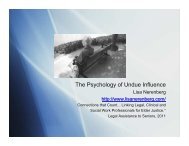Undue Influence: Definitions and Applications - California Courts ...
Undue Influence: Definitions and Applications - California Courts ...
Undue Influence: Definitions and Applications - California Courts ...
You also want an ePaper? Increase the reach of your titles
YUMPU automatically turns print PDFs into web optimized ePapers that Google loves.
esidence (as opposed to, for example, a nursing home or assisted living facility; see Table 10a).<br />
Although it may be an artifact of a small sample, the general conservatorship population<br />
examined in previous studies was much less likely to live in a private residence (37 to 53<br />
percent). PCs most commonly lived alone (40 percent) or with a caregiver or attendant (20<br />
percent). Only 1 of the 25 PCs lived with a spouse who was not also a caregiver. (See Table<br />
10b.)<br />
Having involved family members is commonly viewed as a protective factor against<br />
abuse by strangers. Interestingly, nearly two-thirds (64 percent) of PCs had family members<br />
involved in their lives (see Table 11). However, without additional information about the length<br />
<strong>and</strong> nature of involvement, it is difficult to explain this finding. For example, family members<br />
may have become involved after the PC had already experienced a loss or may have had a direct<br />
or indirect role in the undue influence itself.<br />
All of the PCs had at least one impairment, whether mild or severe. All but two (92<br />
percent) had multiple impairments, with more than two-thirds having five or more. Consistent<br />
with the underlying rationale for many conservatorships, the most common impairments were<br />
related to diminished mental capacity (88 percent), cognition (84 percent), <strong>and</strong> executive<br />
functioning (72 percent). Many PCs also had physical impairments including issues with<br />
mobility (60 percent) <strong>and</strong> activities of daily living (52 percent), as well as mental health issues<br />
(52 percent) <strong>and</strong> depression (44 percent). (See Table 12.)<br />
Court files were reviewed for evidence of other traits of PCs that are sometimes<br />
associated with susceptibility to undue influence. Lack of insight <strong>and</strong> poor judgment (both 88<br />
percent) were by far the most common of these traits. More than one-third (36 percent) of PCs<br />
could be characterized as acquiescent <strong>and</strong> one-quarter (24 percent) could be characterized as<br />
lonely. (See Table 13.)<br />
Characteristics of Alleged Abusers (AAs)<br />
In well over half (60 percent) of cases, there was more than one AA (see Table 14); as a<br />
result, percentages reported are based on the total number of abusers (40) rather than the total<br />
number of cases (25). AAs appeared more likely to be male than female (48 percent versus 30<br />
percent), although the gender of the abuser was unknown in roughly one-quarter cases, primarily<br />
26




